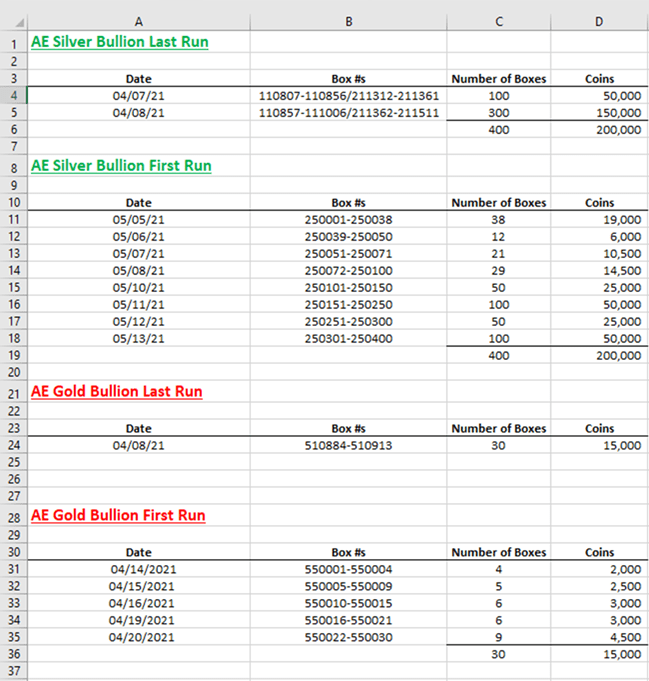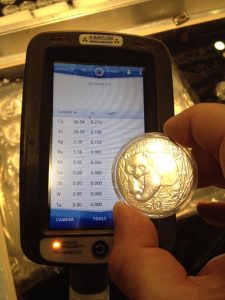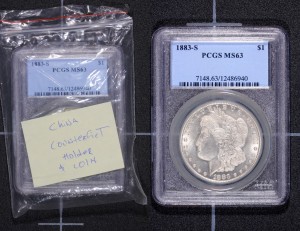Weekly World Numismatic News for August 15, 2021
Although this past week was the World’s Fair of Money, there was not much news surrounding the event. According to individual reports, people said that it was a good show even with the COVID precautions. It was similar to reports from The National, which was held in the Stephens Convention Center the week before.
The week’s biggest news was the U.S. Mint publishing the lot numbers used to label the boxes with the American Eagle bullion coins.
Until last year, the U.S. Mint has not identified where they strike the American Eagle bullion coins. Spokespeople emphasize that since their production is for the investment market, the mint location is not relevant. Of course, collectors view the market differently. Dealers and third-party grading services have tried to determine where the coins were struck based on shipping labels and other factors. Although they are reasonably sure, there are mistakes in their assumptions.
In 2020, the COVID-19 pandemic caused the West Point Mint to close temporarily. To keep up with production, the U.S. Mint struck 240,000 bullion coins in Philadelphia. The third-party grading services asked the U.S. Mint about the production of these coins. Rather than leave the industry guessing, the U.S. Mint identified which boxes contained American Silver Eagle bullion coins struck in Philadelphia. As a result, the third-party grading services accurately noted the origin of the bullion coin on the label of their slab.
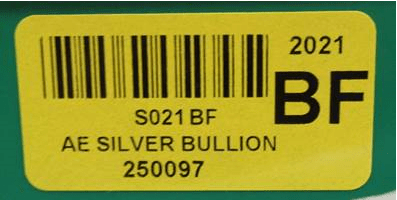
The U.S. Mint reports that some of the boxes marked with “BF” should not have the “F” since they were not part of the first production run.
Although the U.S. Mint has claimed it was always considerate to the collector community, it is the first time they voluntarily provided this information without prompting. Could the U.S. Mint finally be learning from past mistakes? Time will only tell.
And now the news…
 → Read more at smithsonianmag.com
→ Read more at smithsonianmag.com
 → Read more at dailymail.co.uk
→ Read more at dailymail.co.uk
 → Read more at israelhayom.com
→ Read more at israelhayom.com
 → Read more at ynetnews.com
→ Read more at ynetnews.com
 → Read more at tehrantimes.com
→ Read more at tehrantimes.com
Weekly Numismatic World News for September 17, 2017
Working shows in the collectibles and antiques market is no different from a numismatic dealer on the bourse floor. Each dealer specializes in an area and tries to find the right mix of inventory and prices to make the show a success.
Although this sounds like common business sense, there are times when I go to shows and ask the dealers how they are doing I get grumbles from many and smiles from the rest. What I am guessing is that the grumblers have not adapted to the market trends.
I learned that turning over my inventory, regardless of the cost, is very important. Having stale inventory means that my money is tied up in that inventory and does not do me any good invested in that inventory. I have to find fresh items and make sure that those who are regulars and those who want to be regulars know that the next time they see me that I will have something new, even if it is in the category of merchandise I sell.
There are two lessons I have learned in the last few years. First, it is not going to hurt my bottom line if a customer asks for an additional discount such as another $5 or 10-percent off. It makes them feel like they found a bargain and I move the inventory. But that lesson is not possible without my second lesson is to treat the entire inventory as a single unit. By treating the inventory as a single unit, if I sell something at full price to someone who does not want to negotiate but sell the next item for a deeper discount, I am no better off than I thought I would have been.
With some exceptions, I think that many numismatic dealers get stuck with the idea, “this is what I paid so I have the get this price to at least break even.” If I worked that way my truck would come home loaded with inventory and more work to do. However, with the inventory sold, I now have the money to find something fresh for the next show.
Just something for the dealers to think about.
Now for this week’s news:
The value of modern currency comes not from what it's made of, but what we all agree it's worth.
The notion of money has been an important part of the human way of life for more than 2,900 years. When looking back at its origins, there is no doubt that the trade system has evolved considerably. As we mentioned before, bartering was used as the main system for the exchange of all kinds of goods and products.
If anyone should not be on money, it’s Andrew Jackson. The 7th President of the United States hated paper money. He also hated Native Americans and loved having slaves, but for now, let’s focus on how he believed that the United States should only have gold and silver coins as currency.
Ever throw in your two cents? Probably not like a visitor did recently at the Peoria County Courthouse. At the security checkpoint Aug. 31, someone left
In February of 1870, a sparkling new steam-powered coin press inside the United States Mint in Carson City struck its first coin, a Seated Liberty silver dollar with a crisp
From Viking silver to Roman bronze, amateur treasure hunters in Europe locate all kinds of buried treasures with their metal detectors. Now, a new hoard is making headlines: As the ChronicleLive reports, the caretaker of a primary school in Northumberland, England used his own electronic device to find a stash of Medieval-era silver coins buried underneath the school's playground.
My friend Hugo Salinas Price, a tireless promoter of sound money, offers a Primer on the Mexican ‘Libertad’ Silver Ounce as a Vehicle for Savings of the Common Folk. This is a guest post by Hugo Salinas Price.
India issued its first commemorative coin series back in 1964 in the honour of India’s first prime minister Jawaharlal Nehru. It was the same year of Nehru’s passing away. Over the last 53 years, commemorative coins have been issued for various reasons — some as uncirculated collectors items and others for mass circulation.
One-cent coins as well as 10-cent and 25-cent coins will soon no longer be legal tender in Jamaica. (Photo: Jamaica Gleaner)
The Big Maple Leaf was named the largest coin in the world by the Guinness World Records in 2007. But a group of thieves ensured its life in the public spotlight would be brief.
OIG Probe into Mnuchin using government resources expands
Secretary of the Treasury Steven T. Mnuchin seems to think his position with the government affords him perquisites to be paid by the taxpayers.
Last June, Mnuchin married actress Louise Linton at the Andrew W. Mellon Auditorium located near the National Mall. Vice President Pence officiated the ceremony.

Louise Linton and Treasury Secretary Steve Mnuchin are pictured during their honeymoon in Edinburgh, Scotland, Aug. 5, 2017. (Alan Simpson Photography/Splash News)
According to ABC News, an Air Force spokesperson said that a U.S. Air Force jet could cost roughly $25,000 per hour for an international flight. Domestic travel is estimated between $10,000 and $15,000 per hour.
A request for the jet was requested in writing by the Secretary’s office but later deemed unnecessary following a review by Treasury Department officials.
The Department of Treasury Office of the Inspector General (OIG) has acknowledged to ABC that it has opened an official inquiry into this request. This investigation is in addition to the investigation the OIG is making into his trip to Kentucky.
The Treasury Department is also being sued by a public interest research group because the department has not responded to their Freedom of Information Act request.
Mnuchin becomes the first Treasury Secretary since Andrew W. Mellon to be actively investigated for wrongdoing while serving as Secretary.
For reference, articles of impeachment were introduced in the House of Representatives to remove Mellon from office in January 1932. Hearings were held in the House Judiciary Committee. Before the committee voted on the articles of impeachment, Mellon was appointed as the Ambassador to the Court of St. James (the formal name of the Ambassador to the United Kingdom). He resigned as Treasury Secretary and served as an ambassador for a year before retiring to private life.
Mnuchin has not commented on the situation.
How the iPhone X can help numismatics
 On September 12, Apple opened the Steve Jobs Theater on their new campus in Cupertino with an announcement of new hardware. There was the new Apple Watch 3, Apple TV-4K, and two new iPhones.
On September 12, Apple opened the Steve Jobs Theater on their new campus in Cupertino with an announcement of new hardware. There was the new Apple Watch 3, Apple TV-4K, and two new iPhones.
Outside of the tech press, everyone is focused on the iPhone X, “X” for the Roman numeral 10, a marvel of engineering but will cost $1,000. Breaking that $1,000 barrier is a big thing because it makes the iPhone X the most expensive smartphone on the market.
But I see another story that can be more important to a lot of other markets than the price of the device. It is the technology that can be industry altering.
Both the iPhone 8 and iPhone X have dual-lens cameras that are designed to enhance the use of photography. The new cameras have larger sensors that pick up more pixels of information with a processor that can better process the image.
It is the image processing and the iPhone’s ability to use the detailed images to map the terrain, textures, and to use augmented reality (AR) to enhance what the camera sees.
An area where this technology can help numismatics is with computer-based grading.
Computer-based grading was first tried in 1991 using the technology of the day. While it was a good start, the technology was just not ready for the ability to grade coins.
Apple proved that the technology is ready to try again.
Human-based grading has led to an environment of mistrust amongst the grading services. It is the failure of humans to be consistent in grading that leads to religious-like arguments as to which grading service is better. These failures have led the creation of verification services to check up on the ability of grading services to do their job.
The ability for the imaging process to visualize and analyze thousands of polygons on an image, the way imaging technology visualizes the three-dimensional surface, in such a way to allow for real-time expression processing and rendering can be used to assess the surface of a coin.
Another problem that can be resolved is the crack out game. Some people will crack coins out of their slabs to submit them to the grading services multiple times to play on the failure of humans to be consistent to try to have the coins graded higher. The information created based on the surface analysis of the coin will result in digital data that should be unique to each coin. Minute scratches and other environmental factors can help distinguish one coin from another in the same manner that there are subtle differences that can detect on identical twin from another.
Creating a digital signature for each coin will help prevent theft or help law enforcement use the information to track stolen items.
Imaging analysis can look at the surface to find alterations like the use of a chemical that would change the surface. Rather than using the “sniffing” technology that Professional Coin Grading Service has pioneered to find chemical additives, a surface analysis can detect chemical-based alterations to the surface.
Altered surface detection can also be used to detect unnatural toning. It will require teaching the imaging systems to detect the differences between natural and unnatural toning, but the long-term benefits to the hobby will be tremendous.
Aside from grading consistency and the ability detect altered surface, it is possible to expand current technologies that will help detect the use of plated or other metal counterfeits. Devices that are able to visualize a few microns under the surface of the coin to detect the metal content along with the new visualization technologies will make it more difficult to pass counterfeit coins.In the short term, this will not put the third-party grading services out of business but it will change their business. They will not be grading and regrading coins. The computer will analyze the coin, provide the owner with a report, and that report will be consistent regardless of the imaging process used. Otherwise, the coin was altered and you would know about it.
Eventually, this could eliminate the plastic slab that has been counterfeited. The coin itself becomes its own identifier and reduces the reliance on the slab.This technology will eliminate the verification services. There will no need for a human to verify the human-based grading. After all, the fourth-party verification process is artificially driving up the costs of collector coins because of blind trust placed in humans verifying humans.
Although I spent nearly all of my adult life in the technology industry, I am not for technology completely taking over all aspects of our lives. There is a level of trust in the hardware and software that must be earned to have me feel comfortable with things like self-driving cars or even maintaining personal information (see the recent Equifax breach).
However, I am for the use of technology where it can solve a problem. Technology can solve the problem of inconsistent grading. Technology can solve the problem of coin identification. Technology can solve the problems with counterfeiting. Why not use technology to increase the trust in the numismatic market by fixing these problems?
It is now time that technology was put to use in the numismatic and collecting industries in order to create a level of assurance for the collector that their item is genuine and the condition is what the collectible is being represented as.
- iPhone X image courtesy of Apple.
- Niton scanner image by the author.
- Counterfiet PCGS slabs courtesy of PCGS
Treasury Sued for Mnuchin Travel Records
On August 23, CREW filed a Freedom of Information Act (FOIA) request to obtain department records of the trip. They said that Treasury has not responded.
“We filed an expedited FOIA request because Americans deserve more information to determine whether there has been misuse of government resources,” CREW Executive Director Noah Bookbinder said. “We’re suing because the government has so far failed even to respond.”
A report has noted that a Treasury spokesperson confirmed that Mnuchin reimbursed the government for Linton’s travel expenses
[pdf-embedder url=”http://coinsblog.ws/wp-content/uploads/2017/09/CREWvTreasury.pdf” title=”CREW v Treasury”]
Weekly Numismatic World News for September 10, 2017 (TRY 2)
NOTE: A previous version was posted by mistake and then deleted. Sorry!
As I watch the numismatic-related news that is published around the world in the regular media are the number of stories that come out of the United Kingdom and India.Aside from the change over from the “round pound” to the new 12-sided pound coin most of the stories are about what to look for in pocket change. People in the UK are now scrutinizing their pocket change more with the issuance of the new pound coin and it has caused a lot of people to look for the circulating commemoratives issued by the Royal Mint.
Unlike the United States, the primary unit of currency in the UK, the pound, circulates as a coin since the lowest denomination of paper currency is the £5 banknote.
The Royal Mint also produces a £2 coin.
Additionally, the 50 pence coin does circulate and has also been used for commemorative purposes.
Now that the focus is on the new 12-sided pound coin, the other coins have been getting notice. The nation’s tabloids have been writing about these coins generating more interest than the America the Beautiful quarters are receiving here in the United States.
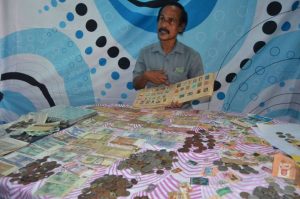
S. John Rajendra Prasad with his collection of ancient coins and rare stamps. (Credit: The Hindu)
The stories that appear in the press the collectors that are highlighted for the volume and longevity of their collections.
Volume seems to be a similar story between the collections. Many of these collections would be classified as hoards based on our societal norms. But rather than lumping the coins together, Indian collectors do sort and separate coins by types, sometimes in a way that makes sense.
I have not had the chance to learn more about the appeal of coins to the Indian society but I find the overall passion for their collecting pursuits quite appealing.
And now the news…
THE Benjamin Bunny 50p coin has now arrived and is the latest commemorative coin to be released by the Royal Mint as part of the Beatrix Potter series. But when exactly did the coin enter circulati…  → Read more at thesun.co.uk
→ Read more at thesun.co.uk
‘Find a penny, pick it up. All day long, you’ll have good luck’ – that’s how the saying goes but what if it was worth enough to keep you going for months? A dad has told of his surprise after being handed a rare 1p coin that could be worth thousands of pounds – because it’s in silver.  → Read more at mirror.co.uk
→ Read more at mirror.co.uk
A hoard of more than 280 gold and silver coins from the time of the Roman invasion of 
Britain has been unearthed by two metal detectorists.  → Read more at granthamjournal.co.uk
→ Read more at granthamjournal.co.uk
The first building block of Australia’s new icebreaker was welded into place at a keel laying ceremony at Damen Shipyard Galati in Romania late last month. The concept design was done by Knud E. Hansen, and Managing Director, Finn Wollesen attended the ceremony, along with Rasmus Nygaard from Friends of Nella Dan.  → Read more at maritime-executive.com
→ Read more at maritime-executive.com
